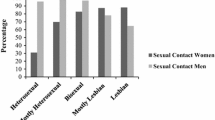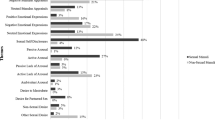Abstract
Arousal-oriented online sexual activities (OSAs) are any activities on the Internet that involve sexually explicit and/or sexually arousing stimuli. These can be solitary-arousal activities, requiring only one person be involved. They can also be partnered-arousal activities that involve at least two people interacting (Shaughnessy, Byers, & Walsh, 2011). Most researchers have focused on the negative outcomes of arousal-oriented OSAs on users’ sexual life and life in general. Yet, these activities can also have positive outcomes. In two separate studies, we examined men’s and women’s perceptions of the positive and negative outcomes of their solitary- and partnered-arousal OSA experience. Study 1 included heterosexual university students (N = 191); Study 2 consisted of heterosexual and sexual minority individuals from the community (N = 316). Participants completed a background questionnaire and measures of their solitary- and partnered-arousal OSA experience and outcomes of these experiences. Overall, solitary- and partnered-arousal OSA was common among study participants. In both studies, participants reported significantly greater positive than negative outcomes of their solitary- and partnered-arousal OSAs, albeit the overall impact was small. We did not find significant gender differences or differences by sexual orientation in positive or negative outcomes of arousal-oriented OSAs. Our results suggest that, for most people, participating in solitary- and partnered-arousal OSAs has little impact on them.
Similar content being viewed by others
References
Albright, J. M. (2008). Sex in America online: An exploration of sex, marital status, and sexual identity in Internet sex seeking and its impacts. Journal of Sex Research, 45, 175–186.
Banks, J. (2010). Regulating hate speech online. International Review of Law, Computers and Technology, 24, 233–239.
Baumeister, R. F., Catanese, K. R., & Vols, K. D. (2001). Is there a gender difference in strength of sex drive? Theoretical views, conceptual distinctions, and a review of relevant evidence. Personality and Social Psychology Review, 5, 242–273.
Black, D. (2000, June 25). Cybersex: Internet chat rooms can become virtual boudoirs…but the fantasies they offer might not be healthy. Toronto Star.
Boies, S. C. (2002). University students’ uses of and reactions to online sexual information and entertainment: Links to online and offline sexual behavior. Canadian Journal of Human Sexuality, 11, 77–89.
Bond, B. J., Hefner, V., & Drogos, K. L. (2009). Information-seeking practices during the sexual development of lesbian, gay, and bisexual individuals: The influence and effects of coming out in a mediated environment. Sexuality and Culture, 13, 32–50.
Byers, E. S. (1996). How well does the traditional sexual script explain sexual coercion? Review of a program of research. Journal of Psychology and Human Sexuality, 8, 7–25.
Cooper, A., Delmonico, D. L., & Burg, R. (2000). Cybersex users, abusers, and compulsives: New findings and implications. Sexual Addiction and Compulsivity, 7, 5–29.
Cooper, A., Delmonico, D. L., Griffin-Shelley, E., & Mathy, R. M. (2004a). Online sexual activity: An examination of potentially problematic behaviors. Sexual Addiction and Compulsivity, 11, 129–143.
Cooper, A., Galbreath, N., & Becker, M. A. (2004b). Sex on the internet: Furthering our understanding of men with online sexual problems. Psychology of Addictive Behaviors, 18, 223–230.
Daneback, K., Cooper, A., & Mansson, S. A. (2005). An Internet study of cybersex participants. Archives of Sexual Behavior, 34, 321–328.
Daneback, K., Ross, M. W., & Månsson, S. (2008). Bisexuality and sexually related activities on the Internet. Journal of Bisexuality, 8, 115–129.
Douthat, R. (2008). Is pornography adultery? The Atlantic Monthly, 302(3), 81–86.
Goodson, P., McCormick, D., & Evans, A. (2001). Searching for sexually explicit materials on the Internet: An exploratory study of college students’ behavior and attitudes. Archives of Sexual Behavior, 30, 101–118.
Griffiths, M. (2001). Sex on the internet: Observations and implications for internet sex addiction. Journal of Sex Research, 38, 333–342.
Grov, C., Gillespie, B. J., Royce, T., & Lever, J. (2011). Perceived consequences of casual online sexual activities on heterosexual relationships: A U.S. online survey. Archives of Sexual Behavior, 40, 429–439.
Hald, G. M., & Malamuth, N. M. (2008). Self-perceived effects of pornography consumption. Archives of Sexual Behavior, 37, 614–625.
Holmberg, D., & Blair, K. L. (2009). Sexual desire, communication, satisfaction, and preferences of men and women in same-sex versus mixed-sex relationships. Journal of Sex Research, 46, 57–66.
Hynes, F., Taylor, N., & Linehan, F. (2007). The role of the mental health professional in cases of online sexual activity. British Journal of Forensic Practice, 9, 19–23.
Kubicek, K., Carpineto, J., McDavitt, B., Weiss, G., & Kipke, M. D. (2011). Use and perceptions of the Internet for sexual information and partners: A study of young men who have sex with men. Archives of Sexual Behavior, 40, 803–816.
Lawrance, K., & Byers, E. S. (1995). Sexual satisfaction in long-term heterosexual relationship: The Interpersonal exchange model of sexual satisfaction. Personal Relationships, 2, 267–285.
McKenna, K. Y. A., Green, A. S., & Smith, P. K. (2001). Demarginalizing the sexual self. Journal of Sex Research, 38, 302–311.
Moor, P. J., Heuvelman, A., & Verleur, R. (2010). Flaming on YouTube. Computers in Human Behavior, 26, 1536–1546.
Petersen, J. L., & Hyde, J. S. (2010). A meta-analytic review of research on gender differences in sexuality, 1993–2007. Psychological Bulletin, 136, 21–38.
Schneider, J. P. (2000). A qualitative study of cybersex participants: Gender differences, recovery issues, and implications for therapists. Sexual Addiction & Compulsivity, 7, 249–278.
Schneider, J. P. (2003). The impact of compulsive cybersex behaviours on the family. Sexual and Relationship Therapy, 18, 329–354.
Schwartz, M. F., & Southern, S. (2000). Compulsive cybersex: The new tea room. Sexual Addiction & Compulsivity, 7, 127–144.
Shaughnessy, K., Byers, E. S., & Walsh, L. (2011). Online sexual activity experience in heterosexual students: Gender similarities and differences. Archives of Sexual Behavior, 40, 419–427.
Smith, A., Rainie, L., & Zickuhr, K. (2011). College students and technology. Research Report. Retrieved April 9, 2013 from Pew Internet and American Life Project website http://www.pewinternet.org/Reports/2011/College-students-and-technology/Report.aspx.
Stephenson, K. R., Ahrold, T. K., & Meston, C. M. (2011). The association between sexual motives and sexual satisfaction: Gender differences and categorical comparisons. Archives of Sexual Behavior, 40, 607–618.
Wiederman, M. W. (2005). The gendered nature of sexual scripts. The Family Journal: Counseling and Therapy for Couples and Families, 13, 496–502.
Author information
Authors and Affiliations
Corresponding author
Rights and permissions
About this article
Cite this article
Shaughnessy, K., Byers, E.S., Clowater, S.L. et al. Self-Appraisals of Arousal-Oriented Online Sexual Activities in University and Community Samples. Arch Sex Behav 43, 1187–1197 (2014). https://doi.org/10.1007/s10508-013-0115-z
Received:
Revised:
Accepted:
Published:
Issue Date:
DOI: https://doi.org/10.1007/s10508-013-0115-z




